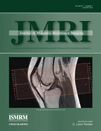Fast 3D 1H MRSI of the corticospinal tract in pediatric brain
Abstract
Purpose
To develop a 1H magnetic resonance spectroscopic imaging (MRSI) sequence that can be used to image infants/children at 3T and by combining it with diffusion tensor imaging (DTI) tractography, extract relevant metabolic information corresponding to the corticospinal tract (CST).
Materials and Methods
A fast 3D MRSI sequence was developed for pediatric neuroimaging at 3T using spiral k-space readout and dual band RF pulses (32 × 32 × 8 cm field of view [FOV], 1 cc iso-resolution, TR/TE = 1500/130, 6:24 minute scan). Using DTI tractography to identify the motor tracts, spectra were extracted from the CSTs and quantified. Initial data from infants/children with suspected motor delay (n = 5) and age-matched controls (n = 3) were collected and N-acetylaspartate (NAA) ratios were quantified.
Results
The average signal-to-noise ratio of the NAA peak from the studies was ≈22. Metabolite profiles were successfully acquired from the CST by using DTI tractography. Decreased NAA ratios in those with motor delay compared to controls of ≈10% at the CST were observed.
Conclusion
A fast and robust 3D MRSI technique targeted for pediatric neuroimaging has been developed. By combining with DTI tractography, metabolic information from the CSTs can be retrieved and estimated. By combining DTI and 3D MRSI, spectral information from various tracts can be obtained and processed. J. Magn. Reson. Imaging 2009;29:1–6. © 2008 Wiley-Liss, Inc.




